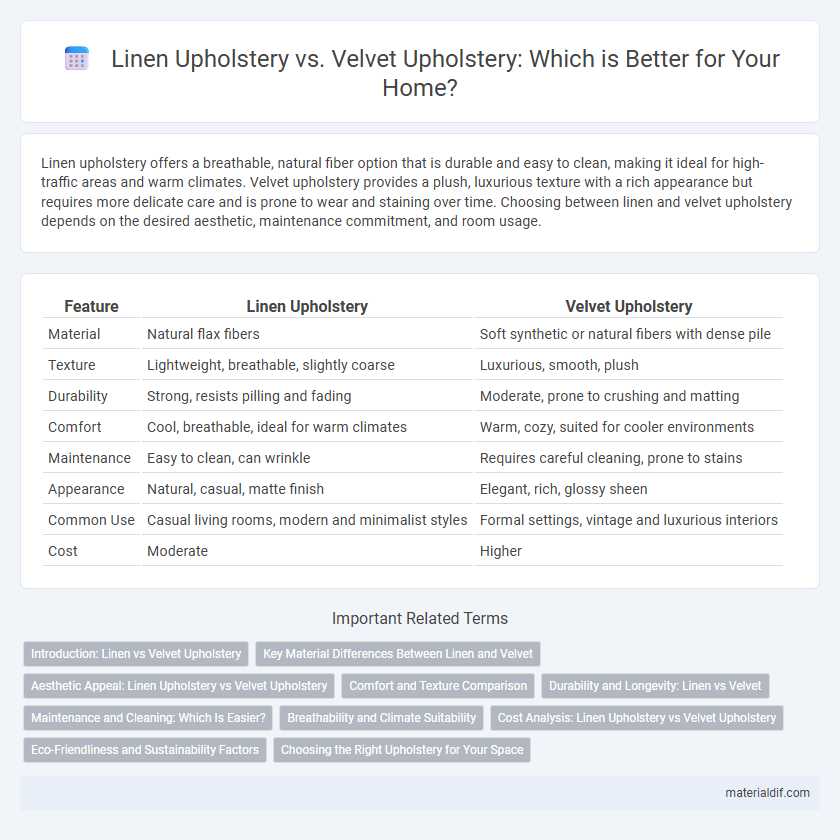Linen upholstery offers a breathable, natural fiber option that is durable and easy to clean, making it ideal for high-traffic areas and warm climates. Velvet upholstery provides a plush, luxurious texture with a rich appearance but requires more delicate care and is prone to wear and staining over time. Choosing between linen and velvet upholstery depends on the desired aesthetic, maintenance commitment, and room usage.
Table of Comparison
| Feature | Linen Upholstery | Velvet Upholstery |
|---|---|---|
| Material | Natural flax fibers | Soft synthetic or natural fibers with dense pile |
| Texture | Lightweight, breathable, slightly coarse | Luxurious, smooth, plush |
| Durability | Strong, resists pilling and fading | Moderate, prone to crushing and matting |
| Comfort | Cool, breathable, ideal for warm climates | Warm, cozy, suited for cooler environments |
| Maintenance | Easy to clean, can wrinkle | Requires careful cleaning, prone to stains |
| Appearance | Natural, casual, matte finish | Elegant, rich, glossy sheen |
| Common Use | Casual living rooms, modern and minimalist styles | Formal settings, vintage and luxurious interiors |
| Cost | Moderate | Higher |
Introduction: Linen vs Velvet Upholstery
Linen upholstery offers a natural, breathable fabric with excellent durability and a subtle texture that enhances casual and elegant interiors alike. Velvet upholstery provides a luxurious, soft surface with rich color depth and a plush feel, ideal for adding warmth and sophistication to living spaces. Choosing between linen and velvet depends on desired aesthetics, maintenance preferences, and the level of comfort sought in furniture upholstery.
Key Material Differences Between Linen and Velvet
Linen upholstery is made from natural flax fibers, offering a breathable, lightweight, and durable fabric with a matte finish that enhances casual or rustic decor. Velvet upholstery consists of densely woven fibers with a soft, plush pile, creating a luxurious texture that captures light and adds depth to formal or elegant interiors. While linen excels in moisture-wicking and temperature regulation, velvet provides superior softness and rich color saturation but requires more maintenance to avoid crushing and wear.
Aesthetic Appeal: Linen Upholstery vs Velvet Upholstery
Linen upholstery offers a natural, textured aesthetic with a matte finish that enhances light, airy interiors and complements minimalist or Scandinavian design styles. Velvet upholstery provides a rich, plush surface with a luminous sheen, adding depth and a luxurious, opulent feel to classic or contemporary settings. The choice between linen and velvet dramatically influences the visual warmth and tactile sophistication of a space.
Comfort and Texture Comparison
Linen upholstery offers a breathable, lightweight texture that feels cool and smooth, ideal for warm climates and casual settings. Velvet upholstery provides a rich, plush surface with a soft pile that creates a luxurious and cozy feel, perfect for colder environments and formal decor. Comfort-wise, linen tends to be more durable and moisture-wicking, while velvet excels in warmth and softness.
Durability and Longevity: Linen vs Velvet
Linen upholstery offers superior breathability and natural strength, making it highly durable and resistant to wear over time, ideal for high-traffic areas. Velvet, while luxuriously soft and visually rich, tends to show signs of wear more quickly due to its delicate pile and susceptibility to crushing and fading. Choosing linen ensures longer-lasting resilience and easier maintenance compared to velvet's plush but less durable finish.
Maintenance and Cleaning: Which Is Easier?
Linen upholstery offers superior breathability and resists dirt accumulation, making it easier to maintain with regular vacuuming and spot cleaning using mild detergent. Velvet upholstery, while luxurious, requires more delicate care, often needing professional cleaning to preserve its texture and avoid crushing the fibers. Choosing linen reduces long-term maintenance effort and costs, especially in high-traffic areas.
Breathability and Climate Suitability
Linen upholstery offers superior breathability due to its natural fiber structure, making it ideal for warm and humid climates by promoting air circulation and moisture-wicking. Velvet upholstery, while luxurious and soft, tends to retain heat and is better suited for cooler environments where insulation is preferred. Choosing linen supports comfort in hot climates, whereas velvet is optimal for maintaining warmth in colder settings.
Cost Analysis: Linen Upholstery vs Velvet Upholstery
Linen upholstery generally costs less than velvet upholstery due to its more affordable raw material and simpler weaving process. Velvet upholstery, made from silk, cotton, or synthetic fibers, commands a higher price because of its luxurious texture and labor-intensive production. When considering durability and maintenance, linen offers cost-effective longevity, while velvet may require additional investment in cleaning and care over time.
Eco-Friendliness and Sustainability Factors
Linen upholstery is highly eco-friendly due to its natural fibers, biodegradability, and minimal water usage during cultivation, making it a sustainable choice. In contrast, velvet upholstery often requires synthetic fibers and energy-intensive manufacturing processes, increasing its environmental impact. Choosing linen supports sustainable living by reducing chemical reliance and promoting renewable agricultural practices.
Choosing the Right Upholstery for Your Space
Linen upholstery offers a breathable, durable, and natural texture ideal for casual or coastal interiors, enhancing comfort and longevity in high-traffic areas. Velvet upholstery provides a luxurious feel with rich color depth and a soft, plush surface that elevates formal living spaces and adds visual warmth. Selecting between linen and velvet depends on the desired aesthetic, maintenance preferences, and the room's functional requirements to achieve the perfect balance of style and practicality.
Linen Upholstery vs Velvet Upholstery Infographic

 materialdif.com
materialdif.com